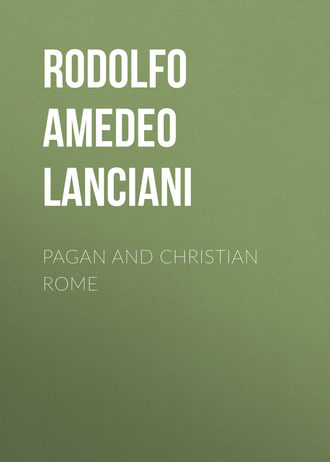 полная версия
полная версияPagan and Christian Rome
In 1714, some beautiful paintings of the first century were discovered in the crypt of the Flavian family (Domitilla) at Torre Marancia. They were examined by well-known archæologists and churchmen, whose names are scratched or written on the walls: Boldetti, Marangoni, Bottari, Leonardo da Porto Maurizio, and G.B. de Rossi (the last two since canonized by the Church), and by hundreds of priests, nuns, missionaries, and pilgrims. No mention is made of this beautiful discovery in contemporary books; but an attempt was made to steal the frescoes, which resulted, as usual, in their total destruction.155 The catacombs owe their sad fate to the riches which they contained. In times of persecution, when the fossores were pressed by too much work and memorial tablets could not be secured in time, it was customary for the survivors to mark the graves of the dear ones either with a symbol, a word, or a date scratched in the fresh cement; or with some object of identification, such as glass cups, medallions, cameos, intaglios, objects cut in rock crystal, coral, etc. If the work of exploration has been carried on actively in the last three centuries, it is on account of the rich harvest which searching parties were sure to reap whenever they chanced to come across a catacomb or part of a catacomb, yet unexplored, with these signs of recognition untouched.
The best works of the glyptic art, the rarest gems, coins, and medallions of European cabinets have come to light in this way. Pietro Sante Bartoli, who chronicled the discoveries made in Rome in the second half of the seventeenth century, speaks several times of treasure-trove in catacombs:156
"In a Christian cemetery discovered outside the Porta Portese, in the vineyard of a priest named degli Effetti, many relics of martyrs have been found, a beautiful set of the rarest medallions (bellissima serie di medaglioni rarissimi), works in metal and crystal, engraved stones, jewels, and other curios and interesting objects, many of which were sold by the workmen at low prices." And again: "The opening of a catacomb was discovered by accident under the Casaletto of Pius V., outside the Porta S. Pancrazio. Although the crypt had never been entered, and promised to be very rich, no excavations were attempted, owing to the dangerous condition of the rock. One object only was extracted from the ruinous cavern; a polychrome cameo of marvellous beauty (di meravigliosa bellezza) representing a Bacchanalian. The stone measured sixteen inches in length by ten in width. It was given to cardinal Massimi."157
The number of catacombs has been greatly exaggerated. Panvinius and Baronius stated it as forty-three; Aringhi and his followers raised this number to sixty. De Rossi, however, in vol. i., p. 206, of the "Roma sotterranea" proves that the number of catacombs excavated during the first three centuries, within a radius of three miles from the walls of Servius Tullius, is but twenty-six; besides eleven of much less importance, and five which were excavated after the Peace of Constantine.
It would be impossible to give even a summary description of these forty-two cemeteries, within the limits of the present chapter. De Rossi's account of Lucina's crypts in the Cemetery of Callixtus occupies one hundred and thirty-two folio pages, and has required thirty-five plates of illustration. I must confine myself to the mention of the few discoveries, connected with the history and topography of underground Rome, which have come within my personal experience, or which I have had occasion to study.
The Catacombs of Generosa. In 1867, while watching with my friend commendatore Visconti (the present director of the Vatican Museum) the excavations of the Sacred Grove of the Arvales, on the Via Campana, five miles outside the Porta Portese, I witnessed for the first time the discovery of a catacomb. The experience could not have been more pleasant, nor the history of the first occupants of these crypts more interesting.
In the persecution of Diocletian two brothers, Simplicius and Faustinus, were tortured and put to death for their faith, and their bodies were thrown into the Tiber from the bridge of Æmilius Lepidus. The stream carried them to a considerable distance, and their young sister Beatrix, who was anxiously watching the banks of the river for the recovery of their dear remains, discovered them lying in the shallows of la Magliana, near the grove of the Arvales. She buried them in a small Christian cemetery which a certain Generosa had excavated close by, under the boundary line of the grove itself. Beatrix, left alone in the world, found shelter in the house of one of the Lucinas; but the persecutors, to whom her pious action had evidently been reported, discovered her retreat, and killed her by suffocation, seven months after the execution of Simplicius and Faustinus. Lucina laid her to rest in the same cemetery of Generosa, by the side of her brothers. This touching story is related in contemporary documents.
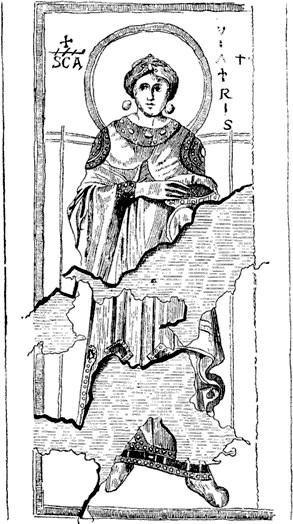
Sancta Viatrix.
Pope Damasus, who in his younger days had been notary and stenographer of the church of Rome, and was acquainted with every detail of the last persecution, raised a small oratory to the memory of the three martyrs, and sanctified the ground which for eleven centuries had been the seat of the worship of the Dea Dia. The chapel lasted until the pontificate of Leo II., when it became evident that the only way of saving the remains of Beatrix, Simplicius, and Faustinus from profanation and robbery, was to remove them from a place so conspicuous for many miles around, and directly in the path of pirates and invaders from the sea, and to place them under the protection of the city walls. The translation took place in 682; the bodies were removed to the church of Santa Biviana, or the Bibiana, on the Esquiline, and placed in a sarcophagus, with the record: "Here lie in peace Simplicius and Faustinus, martyrs, drowned in the Tiber and buried in the cemetery of Generosa, above the landing-place called ad Sextum Philippi." Sarcophagus and inscription are still in existence. The discovery of the oratory of Pope Damasus and the cemetery of Generosa took place, as already stated, in the spring of 1867, when a fragment of the architrave of the altar was found in front of the apse, inscribed with the names, ······ STINO · VIATRICI, engraved in the best Damasian calligraphy. The spelling of the second name deserves attention, because it is certainly intentional, as Damasus and his engraver Furius Dionysius Philocalus are distinguished for absolute epigraphic correctness. Viatrix, the feminine of Viator, is altogether different from Beatrix, and has its own Christian meaning, as an allusion to the eventful journey of human life. Must we take the word Beatrix as a new form, more or less connected with the adjective beatus, or as a corruption of the genuine name? No doubt it is a corruption, as the oldest martyrologies and liturgies have the genuine spelling. The substitution of the B instead of the V took place in the eighth or ninth century, and appears for the first time in the Codex of Berne. The grammarian who wrote it was evidently of the opinion that Viatrix was not the right spelling; and so the true and beautiful name of the sister of Faustinas and Simplicius became corrupted.
The accompanying illustration represents the portrait of Viatrix discovered in the Catacomb of Generosa in the spring of 1868.
The Cemetery of Domitilla. The farm of Torre Marancia, at the crossing of the Via Ardeatina and the Via delle Sette Chiese, is familiar to archæologists on account of the successful excavations which the duchess of Chablais made there in the spring of the years 1817 and 1822. Bartolomeo Borghesi, who first visited them in April, 1817, describes the remains of a noble villa of the first century, with mosaic pavements, fountains, statuary, candelabra, and frescos. The pictures of Pasiphae, Canace, Phædra, Myrrha, and Scylla, which are now in the Cabinet of the Aldobrandini Marriage, in the Vatican Library, were discovered in one of the bedrooms of the villa. Other works of art, now exhibited in the third compartment of the Galleria dei Candelabri, were found in the peristyle. An exact description of these discoveries, with maps and illustrations, is given by Marchese Biondi in a volume called "Monumenti Amaranziani," published in Rome in 1825.
The Villa Amaranthiana, from which the modern name of Torre Marancia is derived, belonged to two ladies, one of imperial descent, Flavia Domitilla, a relative of Domitian and Titus, the other of patrician birth, Munatia Procula, the daughter of Marcus. Domitilla's name appears twice in documents attesting her ownership of the ground; the first is the grant of a sepulchral area, measuring thirty-five feet by forty, to Sergius Cornelius Julianus ex indulgentia Flaviæ Domitillæ; the other mentions the construction of another tomb, Flaviæ Domitillæ divi Vespasiani neptis beneficio.158 These concessions refer to burial-plots above ground, on the Via Ardeatina. Much more important was the permission given by Domitilla for the excavation of a catacomb in the service of the Church, which had just been established in Rome by the apostles. The catacomb consisted originally of two sections; one for the use of those members of the imperial Flavian family who had been converted to the gospel, and one for common use. I have already given a brief account of the first (see p. 10). The entrance to the crypts was built in a conspicuous place, under the safeguard of the law which guaranteed the inviolability of private tombs. The place can still be visited. On each side of the entrance are apartments for the celebration of anniversary banquets, the αγαπαι or love-feasts of the early Church. Those on the left are decorated in the so-called Pompeian style, with birds and festoons on a red ground. Here is the well, the drinking-fountain, the washing-trough, and the wardrobe. On the opposite side is the schola, or banqueting-room, with benches on three sides. There is no doubt that the builders and owners of these crypts were Christians; because the graves within were arranged for the interment of bodies, not for cremation; that is, for sarcophagi and coffins, not for cinerary urns; and, as I stated at the beginning of the previous chapter, the pagans of the first century, and of the first half of the second, were never interred. The Domitilla after whom the catacombs were named was a niece of Vespasian, Divi Vespasiani neptis. The reader will remember that in chapter i. I quoted Xiphilinus as saying that in the year 95 some members of the imperial family were condemned by Domitian on the charge of atheism, together with other leading personages, who had adopted "the customs and persuasion of the Jews,"—an expression which means the Christian faith. Among those condemned he mentions Clemens and Domitilla, whose genealogy is still subject to some uncertainty.
A tombstone discovered in 1741, by Marangoni, in these very catacombs, mentions two names, Flavius Sabinus and Flavia Titiana. They are descendants, perhaps grandchildren, of Flavius Sabinus, the brother of Vespasian. Sabinus was prefect of Rome during the persecution of Nero; but Tacitus159 describes him as a gentle man, who hated violence (mitem virum abhorrentem a sanguine et cædibus). His second son, Titus Flavius Clemens, consul a. d. 82, was executed in 95 on account of his Christian faith; and Flavia Domitilla, his daughter-in-law, was banished for the same cause to the island Pandataria. There is a record of the banishment of another Flavia Domitilla to the island of Pontia; but her genealogy and relationship with the former have not been yet clearly established. Some writers, however, have identified her with the niece of Vespasian, mentioned in the inscription referred to above, as owner of the villa of Torre Marancia and founder of the catacombs. The small island, where she spent many years in solitary confinement, is described by S. Jerome as one of the leading places of pilgrimage in the fourth century of our era.
The "Acta Martyrum" state that Flavia Domitilla, niece of Flavius Clemens, was buried at Terracina, with her attendants, Theodora and Euphrosyne; and that her body-servants, or cubicularii, Nereus and Achilleus, who were executed for the same reason, were laid to rest in the crypts of the Villa Amaranthiana, half a mile from Rome, near the tomb of Petronilla, the so-called daughter of S. Peter. In the early itineraries the place is also indicated as the "cemetery of Domitilla, Nereus, and Achilleus, near Santa Petronilla." Bosio discovered it towards the end of the sixteenth century, and mistook it for the Cemetery of Callixtus. The discoveries made in 1873 leave no doubt as to its identification with the famous burial-place of the Flavians; they brought to light, not a crypt of ordinary dimensions, but a basilica equal in size to the one dedicated to S. Lorenzo by Constantine.
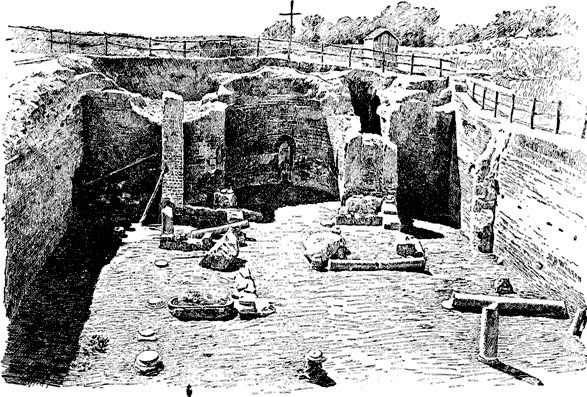
Basilica of Nereus, Achilleus and Petronilla.
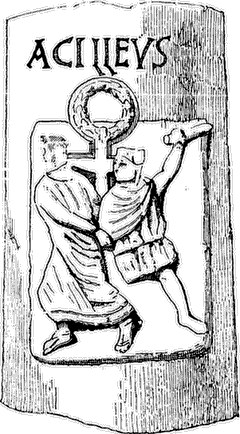
The Execution of Acilleus.
The pavement of the basilica is sunk to the level of the second floor of the catacombs, in order that the graves of Nereus, Achilleus, and Petronilla could be enclosed in the altar, without being raised, or touched at all. The body of the church is divided into nave and aisles by two rows of columns, mostly of cipollino, some of which were stolen in 1871 by the farmer; the others were found in 1876 lying on the floor, in parallel lines from northeast to southwest, as if they had been overthrown by an earthquake.
A fragment of one of the four columns which supported the ciborium above the high altar has been found in the apse. This fragment contains a bas-relief representing the execution of a martyr. The young man is tied to a stake, which is surmounted by a cross-beam, like a T, the true shape of the patibulum cruciforme. A soldier, dressed in a tunic and mantle, seizes the prisoner with the right hand, and stabs him in the neck with the left. The weapon used is not a lictor's axe, nor the sword of a legionary, but a sort of cutlass, which would be more likely to cut the throat than to sever the head from the body. The cross is crowned by a triumphal wreath, as a symbol of the immortal recompense which awaits the confessor of the Faith. The historical value of this rare sculpture is determined by the name, ACILLEVS, engraved above it.
The character of the letters and the style of the bas-relief are those of the second half of the fourth century. Of the sister column, with the name and martyrdom of NEREVS, only a small bit has been found. Another monument of equal value is a broken slab containing, in the first line, the letters ····RVM; in the second, the letters ····ORVM; and below these, the cross-shaped anchor, the mysterious but certain emblem of Christian hope. As the position of the symbol determines the middle point of the inscription, it is easy to reconstruct the whole text, by a careful calculation of the size of each letter:—
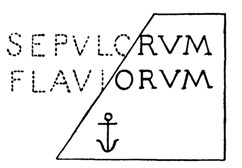
"the tomb of the Flavian family," namely, of those relatives of Domitilla who had embraced the Christian faith.
Under the pavement of the nave, aisles, and presbytery, are numberless graves, some of which belong to the original catacombs, before they were cut and disarranged by the building of the basilica; others are built in accordance with the architectural lines of the basilica itself. A grave belonging to the first series, that is, to a gallery of the catacombs which had been blocked by the foundations of the left aisle, bears the date of the year 390; while a sarcophagus placed at the foot of the altar is dated Monday, May 12, 395. It is evident, therefore, that the basilica was built between 390 and 395, during the pontificate of Siricius.
No memorial of Petronilla, the third saint for whom the building was named, has been found within the sacred enclosure,—a fact not wholly unexpected, because the coffin in which her remains were placed is known to have been removed to the Vatican by Paul I. (755-756), at the request of the king of France. In November, 1875, a cubiculum was found at the back of the apse, connected with it by a corridor which opens near the episcopal chair. The walls of this passage are covered with graffiti and other records of pilgrims. The cubiculum contains two graves: one empty, in the arcosolium, the place of honor; the other, in front of it, of a much later date. The front of the arcosolium is closed by a wall, on the surface of which is an interesting fresco, which is here reproduced.
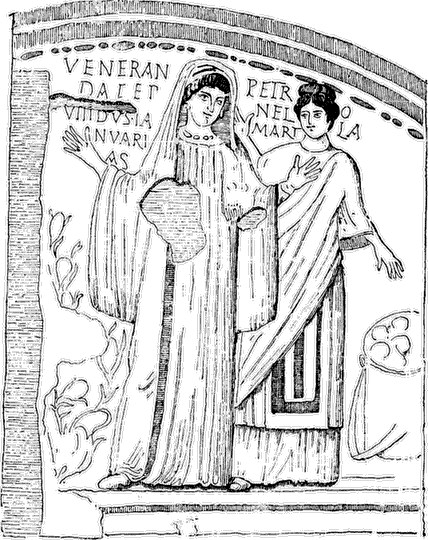
Petronilla and Veneranda.
The younger figure, on the right, is Petronilla Martyr; the elder is a matron named Veneranda, buried January 7 (DEPosita VI. IDVS. IANVARIAS), in the sarcophagus below the picture. There is no doubt that Petronilla was buried in close proximity to this cubiculum. The story of her relationship to S. Peter has no foundation whatever; it rests on an etymological mistake, by which the name Petronilla is treated as a diminutive of Petrus, as is Plautilla of Plautius or Plautia, and Domitilla of Domitius or Domitia. Petrus is not a Latin name; it came into use with the spreading of the gospel, and only in rare and exceptional cases. The young martyr was named after a member of the same Flavian family to which this cemetery belonged, Titus Flavius Petron, an uncle of Vespasian. Her kinship with the apostle must consequently be taken in a spiritual sense.
Towards the end of 1881 another remarkable discovery took place in these catacombs: that of a cubiculum which in style of decoration is unique. It looks more like the room of a Pompeian house than a Christian crypt. Its architectural paintings with groups of frail columns supporting fantastic friezes, and enclosing pastoral landscapes, might be compared to the frescoes of the Golden House of Nero, or those of the house of Germanicus on the Palatine; but they find no parallel in "subterranean Rome."
The name of the owner of this conspicuous tomb is engraved above the arcosolium: AMPLIATI. The size and the beauty of the letters, the peculiarity of a single cognomen in a possessive case, the fact that a man of inferior condition160 should own such a tomb; that at a later period, a staircase had been cut through the rock, to provide a direct communication between the Via Ardeatina and the tomb, for the accommodation of pilgrims; the care used to keep the tomb in good order, as shown by later restorations,—all these circumstances make us believe that Ampliatus was a prominent leader of our early Christian community.
Such being the case, the mind runs at once to the paragraph of S. Paul's Epistle to the Romans (xvi. 8): "Salute Ampliatus my beloved in the Lord," and one feels inclined to kneel before the tomb of the dear friend of the apostle. However, when discoveries of this kind happen, it is wise to proceed with caution, and examine every detail from a sceptical point of view. Doubtless the cubiculum of Ampliatus was made and painted in the first century of our era. The type of the letters engraved above the tomb is peculiar to painted or written inscriptions of the beginning of the second century. It is possible, therefore, that the name was at first painted on the white plaster, and engraved on marble many years after the deposition of Ampliatus. As regards Ampliatus himself, it is true that according to Greek tradition he died when Bishop of Mœsia,161 but the tradition is derived from an apocryphal source. There are those who doubt whether all the salutations contained in S. Paul's epistle are really addressed to the faithful residing in Rome and belonging to the Roman community.162 Another difficulty arises from the fact that in the same cubiculum a tombstone has been found, inserted in the wall above the arcosolium, between two painted peacocks, with this inscription: "Aurelius Ampliatus and his son Gordianus have placed this memorial to Aurelia Bonifatia, wife and mother incomparable, and truly chaste, who lived 25 years, 2 months, 4 days, and 2 hours." Although the name Aurelius is not uncommon on tombstones of the first century in this very Cemetery of Domitilla, there is no doubt that the tablet of Aurelia Bonifatia belongs to a later period. The name Bonifatius—derived from bonum fatum, not from bonum facere as commonly believed—did not come into use before the middle of the second century. At all events, Ampliatus, husband of Bonifatia and father of Gordianus, may be the son, grandson, or even a later descendant of the man in whose memory the cubiculum was originally built.
Shall we recognize in this man the friend of S. Paul? I do not think the question can as yet be answered with certainty. Further excavations in the galleries radiating from the crypt may disclose fresh particulars, and supply more conclusive evidence.
The discoveries of which a summary description has here been given deserve a place of honor in the comments to Suetonius' "Lives of the Emperors." The exploration of underground Rome must be greeted with pleasure, not only by the pious believers in Christ and his martyrs, but also by agnostic students of classical history. A tombstone, which on one side is inscribed with the records of the victories gained by the imperial legions, on the other with the simple and humble name of a Christian who has given his life for his faith, is a monument worthy the consideration of all thoughtful men. Christian archæology has an intimate and indissoluble connection with classical studies, and there is no discovery referring to the first century of Christianity which does not throw new and often unexpected light on general history, art, and science. Those made at Torre Marancia in 1875 illustrate the history of Rome and the Campagna, after the fall of the empire. In the niche where the episcopal chair was placed,—behind the high altar, in the middle of the apse,—a rough hand has sketched the figure of a priest, dressed in a casula, in the act of preaching from his seat. This sketch reminds us of Gregory the Great, when in this very cemetery of Nereus and Achilleus, in this very apse, he read one of his homilies from this episcopal chair, deploring to the panic-stricken congregation the state of the city, the queen of the world, desolated by famine, by pestilence, and by the Lombards, who at that very moment were burning and plundering the villas and farms of the surrounding Campagna.
Cemetery ad catacumbas.163 The cemetery near the church of S. Sebastiano was originally called in an indefinite way cimiterium ad catacumbas. The etymology of the name is uncertain. De Rossi suggests the roots cata, a Græco-Latin preposition of the decadence, signifying "near," and cumba, a resting-place. The word would therefore mean apud accubitoria, "near the resting-places," an allusion to the many tombs which surrounded the old crypt above and below ground. This crypt dates from apostolic times, or, at all events, from a period much earlier than the martyrdom of Sebastian, the Christian officer whose name it now bears.
The great interest of the cemetery is derived from the shelter which the bodies of the apostles are said to have had in its recesses during the fiercest times of persecution. The temporary transferment of the remains of SS. Peter and Paul, from their graves on the Via Cornelia and the Via Ostiensis, to the catacombs, is not a mere tradition. It is described by Pope Damasus in a metric inscription published by de Rossi,164 and by Pope Gregory in an epistle to the empress Constantina, no. 30 of book iv. A curious entry in the calendar called Bucherianum, from its first editor, seems to point to a double transferment. The entry is dated June 29, a. d. 258:—
Tertio Kalendas Julias, Tusco et Basso consulibus, Petri in Vaticano, Pauli in via Ostiensis—utriusque in Catacumbas.
Since, in early calendars, the date is only appended in case of transferment of remains, archæologists have suggested the theory that the bodies of the apostles may possibly have found shelter in the catacombs of the Appian Way a second time, during the persecution of Valerian (a. d. 258). Marchi asserts that the evidences of a double concealment are still to be found in the frescoes of the crypt, some of which belong to the first, others to the third, century; but this hardly seems to be the case. I lowered myself into the hiding-place on February 23 of the present year, and, after careful examination, have come to the conclusion that its paintings are by one hand and of one epoch, the epoch of Damasus. However, whether they were laid there once or twice, its temporary connection with the apostles made the "locus ad catacumbas" one of the great suburban sanctuaries. The cubiculum, called Platonia, was decorated by Damasus with marble incrustations. According to the Acts of S. Sebastian (January 20) he expressed the wish to be buried "ad catacumbas, at the entrance of the crypt, near the memorial of the apostles." These events were represented in the frescoes of the old portico of S. Peter's, destroyed in 1606-1607 by Paul V. One of them showed the bodies of the apostles, bandaged like mummies, being lowered into the place of concealment; the other, Lucina and Cornelius bringing back the bodies to their original graves in the Via Cornelia and the Via Ostiensis.

